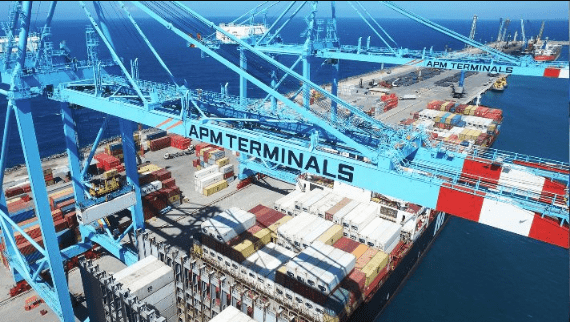
Plaquemines Port in Louisiana and APM Terminals, the terminal operating arm of A.P. Moller-Maersk, have announced an operating agreement to work towards the development of a new deepwater multi-modal “Container Terminal and Intermodal Rail Facility” on the Mississippi River that could potentially handle ships up to 22,000 TEU capacity.
The agreement was signed by Plaquemines Port, Harbor and Terminal District (PPHTD) and APM Terminals following a six-month terminal review process. Each party is now expected to conduct multiple studies prior to making a final investment decision.
Under a Letter of Intent, APM Terminals would operate the terminal, currently in the early phases of development, to be located on 1,000 acres and 8,200 feet of Mississippi River frontage located 50 nautical miles from the Gulf of Mexico. With plans for a 50-foot water depth, the first phase will be designed with the capability to handle 22,000 TEU vessels and the “ability to expand capacity as needed.”
Special focus will be put on using modern infrastructure technology and engineering to withstand storm surges and wind damage, with the port and connecting infrastructure built 16 feet above sea level. The terminal is also planned to be environmentally-friendly, powered by a combination of natural gas and electricity. Phase One of construction is expected to take about 2 years.
Governor of Louisiana John Bel Edwards applauded the announcement of the agreement.
“We’re excited by the prospect of starting a new economic chapter in U.S. ports by developing America’s newest port here in Louisiana, one that has the potential to install new U.S. supply chain capabilities, build new businesses, create new jobs for our great state and generate economic impact throughout our country,” said Gov. Edwards said. “Ports are economic engines and APM Terminals – a leader whose expertise is known globally – is ideally qualified to help us develop and operate one of the newest ports in the world.”
According to the announcement from APM Terminals, the Army Corps of Engineers “will focus on bolstering levees around the site and connecting infrastructure” to reduce the risk of flooding and build a new federal levee system. This system will bring the existing flood protection from a 4-foot height to a new and more robust 14-foot height, which will also tie back into the Mississippi River levees at a height of 15 feet.
Once completed, the system will be able to protect the site from devastating storm surges similar to those of Hurricane Ida, the announcement says. “Construction of the flood protection profile is scheduled for completion in the spring of 2023.”
To further mitigate flood risk, the port has adopted a “Multiple Lines of Defense Strategy” to restore coastal wetlands, in the frontline of the storm surge, and provide additional protection to hurricane levees around the facilities. The port is also working with the Louisiana Coastal Protection and Restoration Authority on developing “restoration and resiliency projects that would provide additional protection to the terminal as well as vulnerable communities outside of the flood protection section.”
“We see tremendous opportunity to write a new supply chain playbook for U.S. exporters and importers with this location,” said Wim Lagaay, CEO of APM Terminals North America. “Exporters are looking for ways to ship their products overseas with a competitive port and importers are looking for more ways to reach major regional consumer markets in the South and Midwest. We look forward to working with the Plaquemines Port Team, their partners and with State and Local leaders to ensure the port operates on world-class levels as a Louisiana success story.”
“Our vision is to create a new port with an entirely new supply chain network into the United States. We will have multiple routing options to inland markets which give supply chain planners the resiliency and contingency layers essential to manage future supply chains effectively,” said PPHTD Executive Director Sandy Sanders. “We have also carefully selected our partners, APM Terminals, American Patriot Holdings and Louisiana 23 Development Company who share our vision to engineer a logistics business model that attracts private investment dollars and new cargo to Louisiana and strategic inland markets.”
“The appeal of Plaquemines protected river port location and export/import market strength makes this a very unique supply chain offering for customers and our growth ambitions,” said APM Terminals’ Lagaay.
Plaquemines Port Harbor & Terminal District was officially established in 1954 as a Political Subdivision of the State of Louisiana. It is the 13th largest port by tonnage in the United States and encompasses the first 80 miles of the Mississippi River from the Gulf of Mexico, offering development opportunities on the west bank for container ports, bulk & break bulk operations, docks and wharfs serving oil & gas, grain, coal, and chemicals markets.